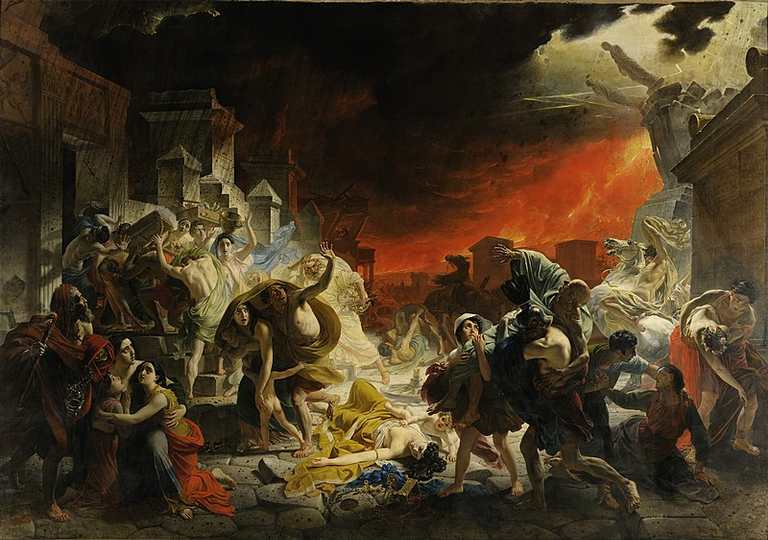
Pompei is a municipality of 25,751 inhabitants in the province of Naples, buried in the 79th century AD by the infamous eruption of Vesuvius.
Its rediscovery and the related excavations, begun in 1748, brought to light an archaeological site that in 1997 became part of the UNESCO World Heritage list, and which is the second most visited Italian monument after the museum system of the Colosseum, Roman Forum and Palatine.
History.
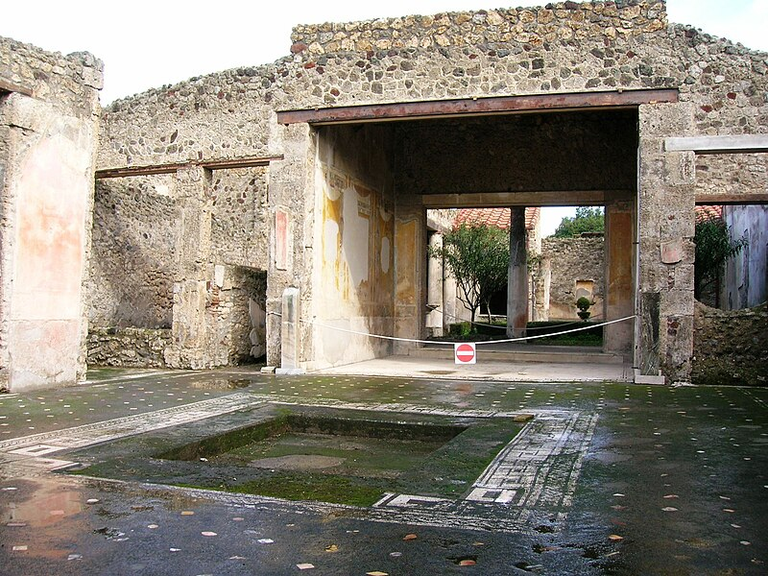
Pompeii has origins as ancient as those of Rome, in fact the gens Pompeia Oschi. descended from one of the first Italic peoples, the Oschi.
Only after the middle of the 7th century BC, a primitive settlement must have been established on the site of the future Pompeii: perhaps not a real settlement, but more likely a small agglomeration around the commercial hub that saw the intersection of three important roads, traced in full historical era by the roads coming from Cuma, Nola and Stabia.
As a mandatory passageway between north and south, Pompeii soon became a prey for the powerful neighboring states, given its importance as a road and port hub. It was conquered for the first time by the Greek colony of Cuma between 525 and 474 BC.
Strabo reports that Pompeii was conquered by the Etruscans. News that in the light of recent excavations becomes increasingly reliable. In the area of the Temple of Apollo and at the Stabian Baths numerous fragments of bucchero have been found, some even with scratched Etruscan inscriptions; also in the area of the Baths, a necropolis from the 6th century BC has come to light.
The first traces of a settlement of a certain importance date back, in Pompeii, to the 6th century BC, even if in this period the city, still rather small, does not reveal the need to use a master plan and seems to be the result of a rather disorderly and spontaneous aggregation of buildings.
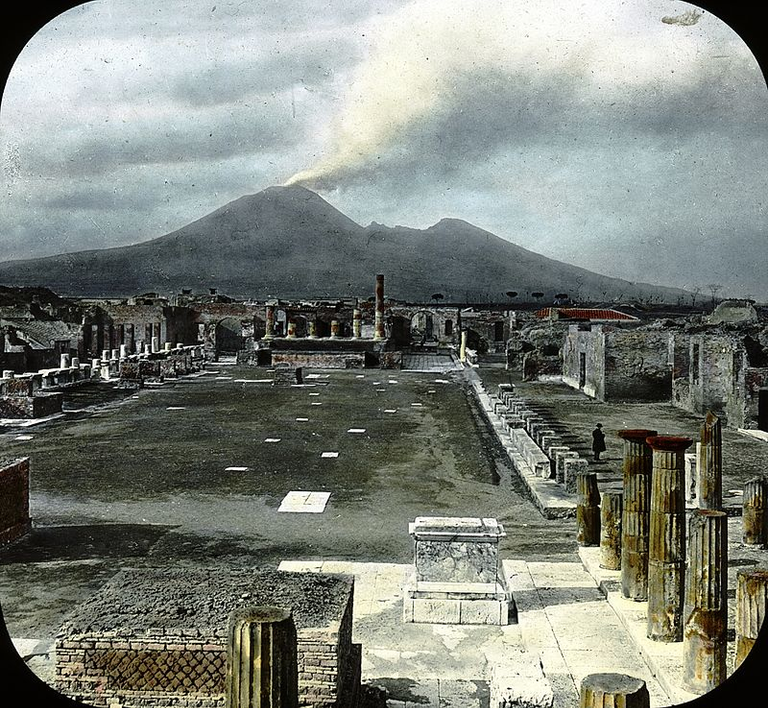
The battle lost by the Etruscans in the waters in front of Cuma against the Cumaeans and Syracusans (mid-5th century BC), brought Pompeii under Greek hegemony. The fortification of the entire plateau with tuff walls that enclosed over sixty hectares probably dates back to this period, even if the city itself did not even reach ten hectares in size.
In the 4th century Pompeii found itself involved in the Samnite Wars (at the end of which RomaCampania) and was forced to accept the condition of member of the Urbe, while maintaining linguistic and institutional autonomy. The first regular urban plan of the city dates back to the 4th century and, around 300 BC, it received the new fortification in Sarno limestone.
During the Second Punic War, Pompeii remained faithful to Rome, unlike many other cities in Campania, and was thus able to maintain its partial independence.
In the 2nd century BC, intensive cultivation of the land and the resulting massive export of wine and oil brought great wealth and a high standard of living to the city: it is enough to remember the richness of some houses and their luxurious furnishings. The House of the Faun, for example, can compete in size (almost 3000 m²) even with the most famous Hellenistic royal residences.
At the outbreak of the Social War (91 BC) we find Pompeii allied against Rome, together with other cities of Campania, in an attempt to obtain full Roman citizenship. But it was impossible to resist the superior military force of Rome: in 89 BC Sulla, after having made Stabiae capitulate, set out for Pompeii, which attempted a strenuous defense by reinforcing the city walls and availing itself of the help of the Celts led by L. Clutentius. Every attempt at resistance was in vain and the city soon fell. In 80 BC it entered completely and definitively into the orbit of Rome and Sulla transferred there a colony of veterans which took the name of Colonia Cornelia Veneria Pompeianorum.
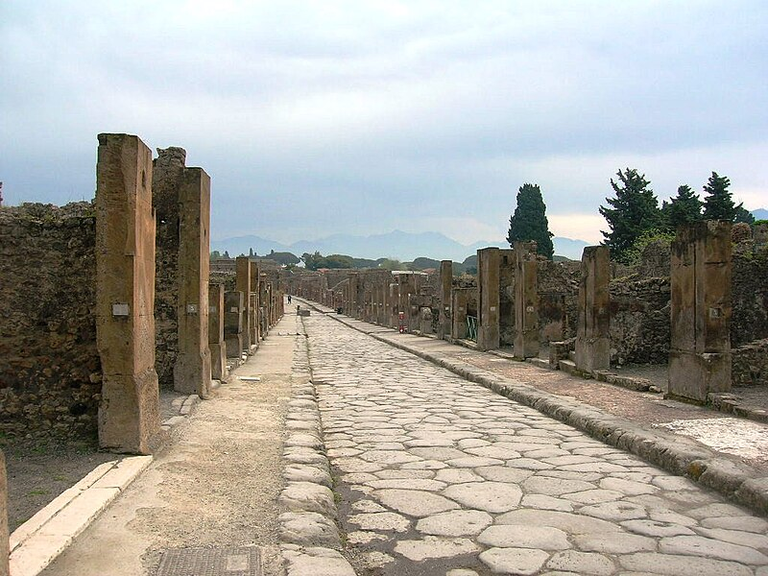
The assignment of lands to veterans certainly occurred to the detriment of the gentes who had most bitterly opposed Sulla. Nonetheless, political and military events did not significantly influence the well-being and commercial enterprise of the Pompeians (aimed especially at the export of Campanian wines) which involved even very remote areas. Due to the salubrity of the climate and the pleasantness of the landscape, the city and its surroundings also constituted a pleasant holiday destination for some wealthy Romans, including Cicero who owned a land there.
Unfortunately, the sources are rather stingy with information about life in Pompeii in the early imperial age. Only Tacitus recalls as a sensational event the brawl that took place between Nucerini and Pompeians in 59 AD in the amphitheatre of Pompeii, which prompted Nero to prohibit, for ten years, any gladiatorial show.
In 62 AD the city was shaken by an earthquake: at the time of the eruption of 79 AD, many buildings were still under reconstruction.
It is the most well-known Plinian eruption, not only of Vesuvius, but of the entire history of volcanology. It was described in two letters from Pliny the Younger (61-114 AD) to the historian Tacitus. These letters constitute the first description of an eruption, hence the name Plinian eruption for this type of particularly violent and destructive phenomenon.
A figure of absolute importance was Bartolo Longo, proclaimed blessed on 26 October 1980 by Pope John Paul II. By his will, the Sanctuary of the Blessed Virgin of the Rosary of Pompeii was erected, now a Pontifical Basilica, rich in votive offerings, which is one of the most popular Italian destinations "for grace received", in which the seventeenth-century canvas of the school of Luca Giordano depicting the Madonna of Pompeii is preserved.
An intense pilgrimage takes place on the occasion of the two supplications to the Madonna on 8 May and the first Sunday in October. We owe to him two other works in favour of needy people, two structures intended to welcome the sons and daughters of prisoners.
By decree, signed on 9 January 2004, by the then President of the Republic Carlo Azeglio Ciampi, Pompeii was elevated to the rank of City.
Pompeii is twinned with the cities of Kjongiu (South Korea), Latiano, Tarragona (Spain) and Xi'an (China). (
Demographic evolution. Population census 200
Railways.
The city of Pompeii is crossed by 3 railway lines: Naples - Sorrento and Naples - Poggiomarino Circumvesuviana and the Naples - Salerno of the FS. On these lines there are several stations that serve various areas of the city.of

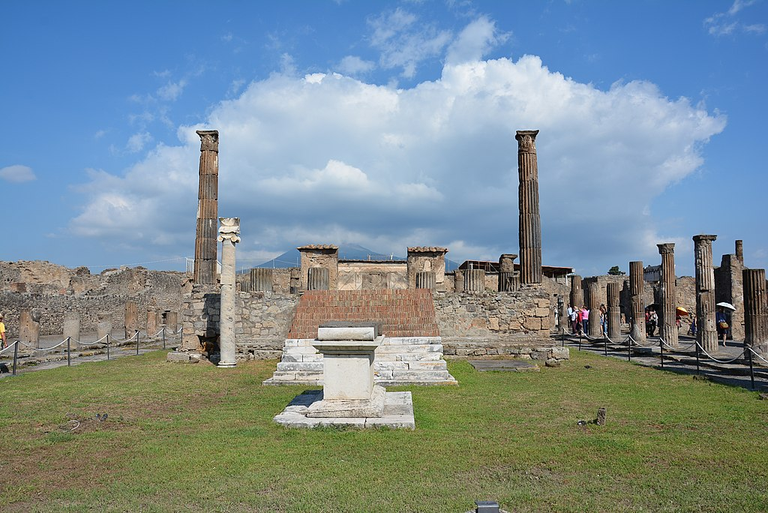
Pompei es un municipio de 25.751 habitantes de la provincia de Nápoles, enterrado en el siglo . 79 d.C. por la tristemente famosa erupción del Vesubio.
Su redescubrimiento y las excavaciones relacionadas, que comenzaron en 1748, sacaron a la luz un sitio arqueológico que en 1997 pasó a formar parte de la lista del patrimonio mundial de la UNESCO y que es el segundo monumento italiano más visitado después del sistema de museos del Coliseo, el Foro Romano y el Palatino.
Historia.
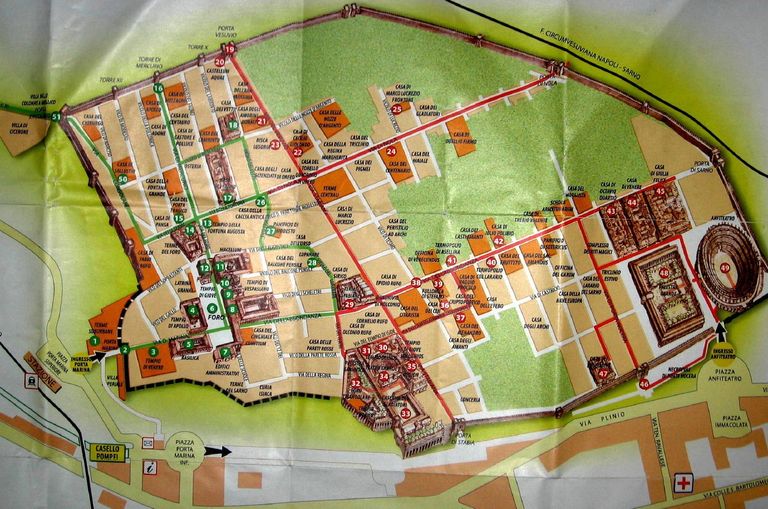
Pompeya tiene orígenes tan antiguos como los de Roma, de hecho la gens Pompeia Oschi. descendía de uno de los primeros pueblos itálicos, los oscos.
Sólo después de mediados del siglo VII a. C. se debió establecer un asentamiento primitivo en el lugar de la futura Pompeya: tal vez no una verdadera ciudad, pero más probablemente una pequeña aglomeración alrededor del centro comercial que vio la intersección de tres carreteras importantes, trazados en medio de la historia a partir de los caminos procedentes de Cuma, Nola y Stabia.
Como lugar de paso obligado entre el norte y el sur, Pompeya pronto se convirtió en presa de los poderosos estados vecinos, dada su importancia como centro viario y portuario. Fue conquistada por primera vez por la colonia griega de Cuma entre el 525 y el 474 a.C.
Estrabón informa que Pompeya fue conquistada por los etruscos. Noticias que a la luz de las recientes excavaciones se vuelven cada vez más fiables. Se han encontrado numerosos fragmentos de bucchero en la zona del templo de Apolo y cerca de las Termas de Estabia, algunos incluso con inscripciones etruscas pintadas; Además, también en la zona de las Termas ha salido a la luz una necrópolis del siglo VI a.C. Los primeros vestigios de un asentamiento de cierta importancia se remontan a Pompeya en el siglo VI a. C., aunque en este período la ciudad, todavía bastante pequeña, no revela la necesidad de utilizar un plan maestro y parece ser el resultado de una agregación de edificios bastante desordenada y espontánea. La batalla perdida por los etruscos en las aguas de Cuma contra los cumanos y siracusanos (mediados del siglo V a. C.) puso a Pompeya bajo la hegemonía griega.
Probablemente de esta época se remonta a la fortificación de toda la meseta con murallas de toba que rodeaban más de sesenta hectáreas, aunque la ciudad actual no alcanzaba ni siquiera las diez hectáreas. En el siglo IV, Pompeya se vio envuelta en las guerras samnitas (al final de las cuales Roma-Campania) y se vio obligada a aceptar el estatus de miembro de la ciudad, manteniendo al mismo tiempo su autonomía lingüística e institucional. El primer trazado urbano regular de la ciudad se remonta al siglo IV y, hacia el 300 a. C., recibió la nueva fortificación de piedra caliza de Sarno.
Durante la Segunda Guerra Púnica, Pompeya permaneció fiel a Roma, a diferencia de muchas otras ciudades de Campania, y así pudo mantener su independencia parcial.
En el siglo II a. C., el cultivo intensivo de la tierra y la consiguiente exportación masiva de vino y aceite trajeron a la ciudad una gran riqueza y un alto nivel de vida: bastaría recordar la riqueza de algunas casas y su lujoso mobiliario. La Casa del Fauno, por ejemplo, puede rivalizar en tamaño (casi 3.000 m²) incluso con las residencias reales helenísticas más famosas. Al estallar la guerra social (91 a. C.) encontramos a Pompeya aliada contra Roma, junto con otras ciudades de Campania, en un intento de obtener la ciudadanía romana plena.
Pero fue imposible resistir a la fuerza militar superior de Roma: en el 89 a. C. Silla, después de haber hecho capitular a Estabia, partió hacia Pompeya, que intentó una enérgica defensa reforzando las murallas de la ciudad y aprovechando la ayuda de los celtas liderados por Lucio Clutencio. Todo intento de resistencia fue en vano y la ciudad pronto cayó. En el 80 a. C. entró total y definitivamente en la órbita de Roma y Sila trasladó allí una colonia de veteranos que tomó el nombre de Colonia Cornelia Veneria Pompeianorum.
La asignación de tierras a los veteranos ciertamente se produjo en detrimento de las gentes que se habían opuesto más acérrimamente a Sila. Sin embargo, los acontecimientos políticos y militares no tuvieron una influencia decisiva en el bienestar y la actividad comercial de los pompeyanos (orientada sobre todo a la exportación de vinos de Campania), que afectó también a zonas muy remotas. Debido al buen clima y al agradable paisaje, la ciudad y sus alrededores también constituyeron un agradable lugar de vacaciones para algunos romanos ricos, entre ellos Cicerón, que poseía una finca allí.
Desafortunadamente, las fuentes son bastante escasas en información sobre la vida en Pompeya a principios de la época imperial. Sólo Tácito recuerda como un hecho sensacional la reyerta que tuvo lugar entre Nucerini y Pompeyanos en el año 59 d.C. en el anfiteatro de Pompeya, que empujó a Nerón a prohibir allí durante diez años cualquier espectáculo de gladiadores. En el año 62 d. C., la ciudad fue sacudida por un terremoto: en el momento de la erupción en el año 79 d. C., muchos edificios aún estaban en reconstrucción. Se trata de la erupción pliniana más conocida, no sólo del Vesubio, sino de toda la historia de la vulcanología. Fue descrito en dos cartas de Plinio el Joven (61-114 d.C.) al historiador Tácito. Estas cartas constituyen la primera descripción de una erupción, de ahí el nombre de erupción pliniana para este tipo de fenómeno particularmente violento y destructivo.
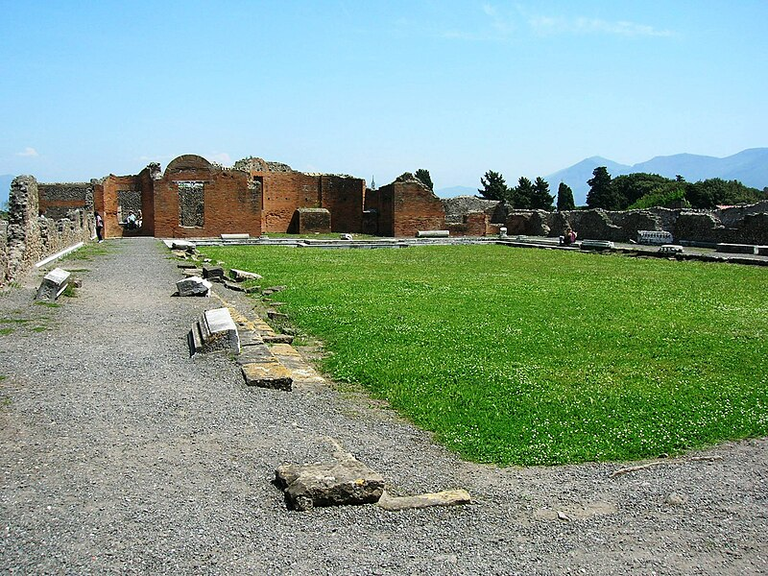
Una figura muy importante fue Bartolo Longo, proclamado beato el 26 de octubre de 1980 por el Papa Juan Pablo II. Por voluntad suya se erigió el Santuario de la Santísima Virgen del Rosario de Pompeya, hoy Basílica Pontificia, repleta de exvotos, que constituye uno de los destinos italianos más populares "por la gracia recibida", en el que se exponen los lienzos del siglo XVII. De la escuela de Luca se conserva Giordano que representa a la Virgen de Pompeya.
Una intensa peregrinación se produce con motivo de las dos súplicas a la Virgen el 8 de mayo y el primer domingo de octubre. Le debemos otras dos obras en favor de los necesitados, dos estructuras destinadas a la acogida de hijos e hijas de personas encarceladas. Por decreto, firmado el 9 de enero de 2004, por el entonces Presidente de la República Carlo Azeglio Ciampi, Pompeya fue elevada al rango de ciudad. Pompeya está hermanada con las ciudades de Kjongiu (Corea del Sur), Latiano, Tarragona (España) y Xi'an, China). ( Evolución demográfica. Habitantes censados en el año 200 a.C.
Ferrocarriles.
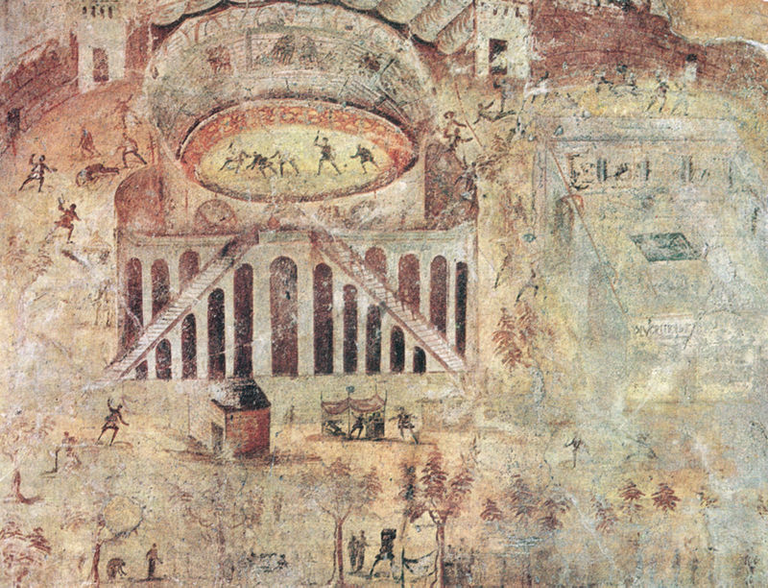
La ciudad de Pompeya está atravesada por 3 líneas ferroviarias: Nápoles - Sorrento y Nápoles - PoggiomarinoCircumvesuviana y la Nápoles - Salerno de la FS. En estas líneas existen varias estaciones que dan servicio a diversas zonas de la ciudad.desde
Source images 7 Fuente imágenes: Pompei.
center>
Upvoted. Thank You for sending some of your rewards to @null. Get more BLURT:
@ mariuszkarowski/how-to-get-automatic-upvote-from-my-accounts@ blurtbooster/blurt-booster-introduction-rules-and-guidelines-1699999662965@ nalexadre/blurt-nexus-creating-an-affiliate-account-1700008765859@ kryptodenno - win BLURT POWER delegationNote: This bot will not vote on AI-generated content
Thanks @ctime and curators team!